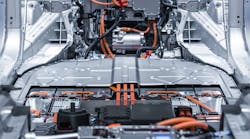This article is part of the TechXchange: EV Battery Management
What you’ll learn:
- The high cost associated with increased use of silicon in the anode of EV batteries.
- A new solution that involves fusing silicon nanowires directly onto existing commercial graphite.
At COP26, a large group of automakers signed a declaration to accelerate the transition to 100% zero emission cars and vans by 2040 globally and 2035 in leading markets. This action should not come as a surprise to those in the EV market—automakers around the world are racing to create 100% electric fleets as consumer and regulatory demand heats up.
However, the declaration does bring to light many of the barriers and challenges currently plaguing the industry. Consumers are demanding that their new electric vehicles have faster charging speeds and longer range, and, most importantly, are more affordable. In turn, automakers are looking to find new and innovative solutions to satisfy consumers.
One manufacturing process that’s gained traction—and is even viewed by some as the breakthrough needed to produce EVs that meet market demand for high performance—is to increase the amount of silicon in EV batteries. Many are looking to silicon because of is its ability to store 10X more energy than graphite alone, vastly improving the range, charging speed, and life of EV batteries. Silicon is already being deployed in the batteries of a few EV models including Tesla Y, Tesla 3, and Porsche Taycan.
The Problem: Cost
To date, this has been a cost-prohibitive process plagued by technical challenges and with only small amounts of silicon able to be added. Thus, only modest improvements have been achieved in battery performance.
Many have experimented with encapsulating nanosilicon particles into a new type of carbon or polymer matrix mixed with inactive additives and graphite powders. However, capital equipment and manufacturing costs make these options hard to execute in a cost-efficient manner.
When contemplating scaling up to supply meaningful quantities required for millions of EVs, new equipment must be designed, built, and tested. This increases risks, upfront investments, and maintenance costs. In addition, the high-energy consumption costs associated with manufacturing and the low yields of these solutions come with a significant carbon footprint.
The New Solution
Rather than try to replace existing suppliers, we must think of a new process that replaces inefficient steps in the development of silicon additives. The technology should be scalable, and increase performance and decrease costs of the materials and cells used in EVs. A breakthrough solution involves fusing silicon nanowires directly onto existing commercial graphite without inactive additives and without requiring the mixing of silicon-comprising powders with graphite powders.
It's practical to increase the anode energy density and charging speed while also decreasing anode costs and carbon footprint using nanowires (see figure). The SINANODE process redefines the performance and cost of the battery while leveraging every aspect of the current value chain, This is the case for the graphite powders already produced at large scale and existing manufacturing investments as it relates to large solar-cell factories and EV-cell factories.
In a few years, EVs without silicon added to graphite in the battery will become increasingly obsolete. Finding new and innovative solutions that offer added value to current manufacturing processes will be the cost-efficient and scalable solution.
New declarations and demands to accelerate EV production are emerging every day as we all race for 2025. Simplifying the process and cost as it relates to silicon will be our solution, one that fulfills our promise to the planet and consumers.
Read more articles in the TechXchange: EV Battery Management
